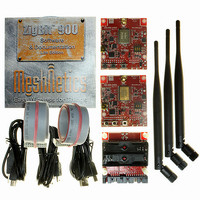MNZB-DKL-900 MeshNetics, MNZB-DKL-900 Datasheet - Page 43

MNZB-DKL-900
Manufacturer Part Number
MNZB-DKL-900
Description
KIT DEV ZIGBIT 900 LITE 45DAYS
Manufacturer
MeshNetics
Type
802.15.4/Zigbeer
Datasheet
1.MNZB-EVB-900-B0.pdf
(56 pages)
Specifications of MNZB-DKL-900
Frequency
868MHz, 915MHz
For Use With/related Products
MNZB-900-B0
Lead Free Status / RoHS Status
Lead free / RoHS Compliant
Other names
758-1010
© 2008 MeshNetics
7.3. How to Build Minimum Application
7.4. Sample Applications
The easiest way to configure an AVR project is to use Makefile that is a plain text file
which name has no extension. Makefile specifies compilation and linking flags. Makefile
also specifies corresponding directories in order to include header files and to link the
system object libraries.
The required BitCloud software is located in ZDK Distribution CD in the “BitCloud”
structured subdirectory as presented in Appendix A.
For a quick start in programming, a user’s sample application is designed to show the
required application structure and coding conventions. This application (a local variety of
the traditional "Hello World" demo) implements permanent blinking of the MeshBean2’s
LEDs, using the GPIO interface. The source code for minimum application is given in
Appendix C , along with the Makefile corresponding to the file structure specified in
Appendix A. Both are located in the “./Sample Applications/Blink/“ subdirectory.
The resulting image files are also delivered. You can rebuild them any time as described
below.
Open blink.aps file from the “./Sample Applications/Blink/“ subdirectory and
just execute Build/Rebuild All item from the main menu of AVR Studio. The
blink.hex and blink.srec image files will be generated. No *.eep image file will be
produced as EEPROM is not needed for Blink. To test the minimum application, upload
any of the image files into a MeshBean2 board, following the instructions which are given
in Section 6 or in Appendix B, correspondingly.
You can modify the code to extend the application’s functionality by using other BitCloud
API functions. Make sure that your application code satisfies the programming
conventions specified in [5].
Play with the other API demos (see Section 7.4), building them similarly to enhance the
application with new functionalities. Make sure your applications are uploaded into the
boards before use.
ZDK is supplied with the set of BitCloud API sample applications in source code. These
are named as given in brackets:
WSNDemo is a ZDK featured application demonstrating the formation of network based
on BitCloud software and MeshBean2 hardware. In WSNDemo, the nodes communicate
based on a proprietary messaging protocol. WSNDemo is presented in details in Section
4.
The source codes for WSNDemo application can be found inside the
“./Sample Applications/WSNDemo“ subdirectory (see Appendix A), once the
Development Kit is installed to user’s PC (see Section 3.3).
•
•
•
•
•
WSNDemo application (WSNDemo)
Low-Power Networking application (Lowpower)
Peer-to-Peer Data Exchange application (Peer2peer)
Ping-Pong application (Pingpong)
Hardware Test (HardwareTest).
Z I G B I T ™ 9 0 0 D E V E L O P M E N T K I T 1 . 3
U S E R ’ S G U I D E
Page 43/56
























